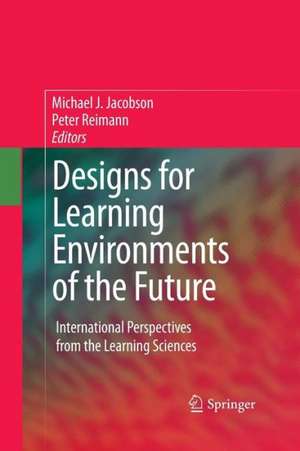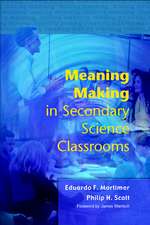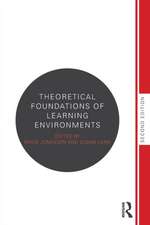Designs for Learning Environments of the Future: International Perspectives from the Learning Sciences
Editat de Michael Jacobson, Peter Reimannen Limba Engleză Paperback – 4 sep 2014
Focusing on ideas about designing innovative environments for learning in areas such as biology, engineering, genetics, mathematics, and computer science, the book surveys a range of learning technologies being explored around the world—a spectrum as diverse as digital media, computer modeling, and 3D virtual worlds—and addresses challenges arising from their design and use. The editors’ holistic perspective frames these innovations as not only discrete technologies but as flexible learning environments that foster student engagement, participation, and collaboration. Contributors describe possibilities for teaching and learning in these and other cutting-edge areas:
- Working with hypermodels and model-based reasoning
- Using visual representations in teaching abstract concepts
- Designing strategies for learning in virtual worlds
- Supporting net-based collaborative teams
- Integrating innovative learning technologies into schools
- Developing personal learning communities
Designs for Learning Environments of the Future will enhance the work of a wide range of professionals, including researchers and graduate students in the learning and cognitive sciences, and educators in the physical and social sciences.
| Toate formatele și edițiile | Preț | Express |
|---|---|---|
| Paperback (1) | 1108.19 lei 6-8 săpt. | |
| Springer Us – 4 sep 2014 | 1108.19 lei 6-8 săpt. | |
| Hardback (1) | 1114.34 lei 6-8 săpt. | |
| Springer Us – 18 feb 2010 | 1114.34 lei 6-8 săpt. |
Preț: 1108.19 lei
Preț vechi: 1351.46 lei
-18% Nou
Puncte Express: 1662
Preț estimativ în valută:
212.06€ • 226.76$ • 176.80£
212.06€ • 226.76$ • 176.80£
Carte tipărită la comandă
Livrare economică 18 aprilie-02 mai
Preluare comenzi: 021 569.72.76
Specificații
ISBN-13: 9781489983633
ISBN-10: 1489983635
Pagini: 304
Ilustrații: XI, 291 p.
Dimensiuni: 155 x 235 x 16 mm
Greutate: 0.43 kg
Ediția:2010
Editura: Springer Us
Colecția Springer
Locul publicării:New York, NY, United States
ISBN-10: 1489983635
Pagini: 304
Ilustrații: XI, 291 p.
Dimensiuni: 155 x 235 x 16 mm
Greutate: 0.43 kg
Ediția:2010
Editura: Springer Us
Colecția Springer
Locul publicării:New York, NY, United States
Public țintă
ResearchDescriere
Few things are as certain as societal changes—and the pressing need for educators to prepare students with the knowledge and ways of thinking necessary for the challenges in a changing world. In the forward-thinking pages of Designs for Learning Environments of the Future, international teams of researchers present emerging developments and findings in learning sciences and technologies at the infrastructure, curricular, and classroom levels.
Focusing on ideas about designing innovative environments for learning in areas such as biology, engineering, genetics, mathematics, and computer science, the book surveys a range of learning technologies being explored around the world—a spectrum as diverse as digital media, computer modeling, and 3D virtual worlds—and addresses challenges arising from their design and use. The editors’ holistic perspective frames these innovations as not only discrete technologies but as flexible learning environments that foster student engagement, participation, and collaboration. Contributors describe possibilities for teaching and learning in these and other cutting-edge areas:
Designs for Learning Environments of the Future will enhance the work of a wide range of professionals, including researchers and graduate students in the learning and cognitive sciences, and educators in the physical and social sciences.
Focusing on ideas about designing innovative environments for learning in areas such as biology, engineering, genetics, mathematics, and computer science, the book surveys a range of learning technologies being explored around the world—a spectrum as diverse as digital media, computer modeling, and 3D virtual worlds—and addresses challenges arising from their design and use. The editors’ holistic perspective frames these innovations as not only discrete technologies but as flexible learning environments that foster student engagement, participation, and collaboration. Contributors describe possibilities for teaching and learning in these and other cutting-edge areas:
- Working with hypermodels and model-based reasoning
- Using visual representations in teaching abstract concepts
- Designing strategies for learning in virtual worlds
- Supporting net-based collaborative teams
- Integrating innovative learning technologies into schools
- Developing personal learning communities
Designs for Learning Environments of the Future will enhance the work of a wide range of professionals, including researchers and graduate students in the learning and cognitive sciences, and educators in the physical and social sciences.
Cuprins
Preface, Michael J. Jacobson and Peter Reimann Chapter 1. Invention and Innovation in Designing Future Learning Environments, Michael J. Jacobson and Peter Reimann Chapter 2. MaterialSim: A Constructionist Agent-based Modeling Approach to Engineering Education, Paulo Blikstein and Uri Wilensky Chapter 3. Learning Genetics from Dragons: From Computer-Based Manipulatives to Hypermodels, Paul Horwitz, Janice D. Gobert, Barbara C. Buckley, and Laura M. O’Dwyer Chapter 4. The Development of River City, a Multi-User Virtual Environment-based Scientific Inquiry Curriculum: Historical and Design Evolutions, Diane Jass Ketelhut, Jody Clarke, and Brian Carl Nelson Chapter 5. Design Perspectives for Learning in Virtual Worlds, Michael J. Jacobson, Beaumie Kim, Chunyan Miao, Zhiqi Shen, and Mark Chavez Chapter 6. Learning to Learn and Work in Net-based Teams: Supporting Emergent Collaboration with Visualization Tools, Peter Reimann and Judy Kay Chapter 7. Learning Mathematics Through Inquiry: A Large Scale Evaluation, Ton de Jong, Petra Hendrikse, and Hans van der Meij Chapter 8. Scaffolding Knowledge Communities in the Classroom: New Opportunities in the Web 2.0 Era, Vanessa Peters and James D. Slotta Chapter 9. From New Technological Infrastructures to Curricular Activity Systems: Advanced Designs for Teaching and Learning, Jeremy Roschelle, Jennifer Knudsen, and Stephen Hegedus Chapter 10. Towards a Theory of Personalized Learning Communities, Eric Hamilton and Martine Jago Chatper 11. Afterword:Opportunities for Transformational Learning, Peter Reimann and Michael J. Jacobson
Textul de pe ultima copertă
Few things are as certain as societal changes—and the pressing need for educators to prepare students with the knowledge and ways of thinking necessary for the challenges in a changing world. In the forward-thinking pages of Designs for Learning Environments of the Future, international teams of researchers present emerging developments and findings in learning sciences and technologies at the infrastructure, curricular, and classroom levels.
Focusing on ideas about designing innovative environments for learning in areas such as biology, engineering, genetics, mathematics, and computer science, the book surveys a range of learning technologies being explored around the world—a spectrum as diverse as digital media, computer modeling, and 3D virtual worlds—and addresses challenges arising from their design and use. The editors’ holistic perspective frames these innovations as not only discrete technologies but as flexible learning environments that foster student engagement, participation, and collaboration. Contributors describe possibilities for teaching and learning in these and other cutting-edge areas:
Designs for Learning Environments of the Future will enhance the work of a wide range of professionals, including researchers and graduate students in the learning and cognitive sciences, and educators in the physical and social sciences.
Focusing on ideas about designing innovative environments for learning in areas such as biology, engineering, genetics, mathematics, and computer science, the book surveys a range of learning technologies being explored around the world—a spectrum as diverse as digital media, computer modeling, and 3D virtual worlds—and addresses challenges arising from their design and use. The editors’ holistic perspective frames these innovations as not only discrete technologies but as flexible learning environments that foster student engagement, participation, and collaboration. Contributors describe possibilities for teaching and learning in these and other cutting-edge areas:
- Working with hypermodels and model-based reasoning
- Using visual representations in teaching abstract concepts
- Designing strategies for learning in virtual worlds
- Supporting net-based collaborative teams
- Integrating innovative learning technologies into schools
- Developing personal learning communities
Designs for Learning Environments of the Future will enhance the work of a wide range of professionals, including researchers and graduate students in the learning and cognitive sciences, and educators in the physical and social sciences.
Caracteristici
Provides a representative survey of the wide range of types of advanced learning technologies
Internationally recognized authors known for their innovative approaches for designing and using technologies that support learner-centered pedagogy
Discusses a variety of theories and research principles
Includes supplementary material: sn.pub/extras
Internationally recognized authors known for their innovative approaches for designing and using technologies that support learner-centered pedagogy
Discusses a variety of theories and research principles
Includes supplementary material: sn.pub/extras










